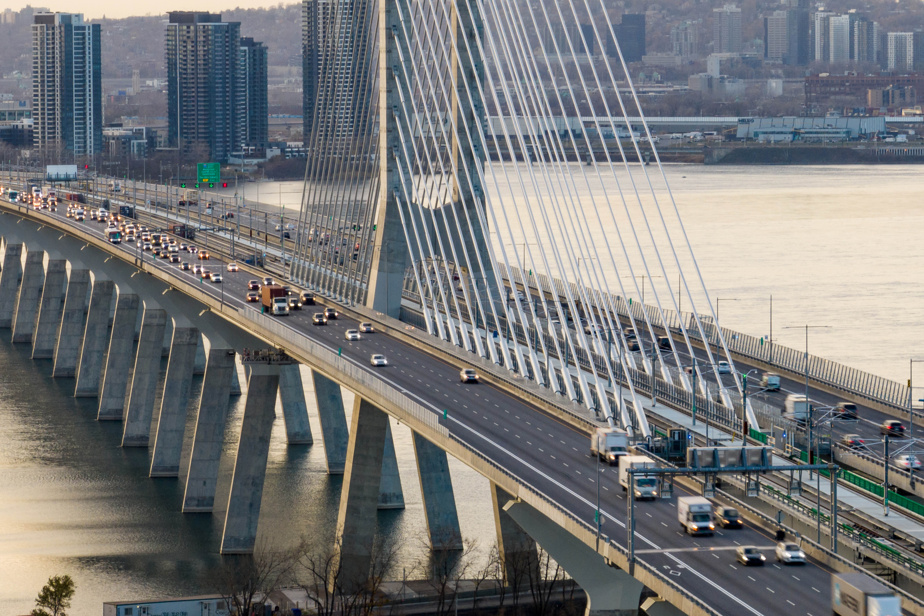Car traffic is back to pre-pandemic levels in the majority of regions of Quebec… except Greater Montreal. The advent of teleworking and the proliferation of construction sites continue to disrupt the habits of motorists in the metropolitan region, experts and the transport industry judge.
This is what data collected by The Press based on traffic volumes published annually on the website of the Ministry of Transport and Sustainable Mobility. These figures make it possible to monitor changes in traffic on each infrastructure and major roadway.
During the pandemic, automobile traffic fell on average by 10% to 20% on Quebec roads. Since then, ridership has gradually recovered in the majority of regions.

PHOTO PATRICE LAROCHE, LE SOLEIL ARCHIVES
In 2023, the Quebec region recorded 98% of its pre-pandemic trips.
In 2023, the Quebec and Gatineau regions accounted for 98% of the trips recorded in 2019.
Sherbrooke and Trois-Rivières even observed flow rates slightly higher than the pre-pandemic period.

Meanwhile, in the metropolitan area, the traffic recovery is much less strong. In Greater Montreal, travel remains 5% lower than what was recorded in 2019.
The drop is also particularly marked on several inter-river bridges such as Victoria (-38%) or Papineau-Leblanc (-13%). The bridges on axes 125 and 40 are also following a clear downward trend. On average, there are approximately 10% fewer vehicle pools on bridges than previously observed.
Quieter to the south
This decrease is particularly felt on the South Shore, where to date we have reached approximately 91% of pre-COVID-19 trips. It must be said that major construction projects have disrupted habits there.
The Louis-Hippolyte-La Fontaine tunnel, where three out of six lanes have been closed since October 2022 due to a major makeover, is the best example. Since 2019, daily ridership has fallen from 121,000 to 57,000 passages, a drop of almost 53%.

Other structures such as the Jacques-Cartier Bridge, however, remain widely used. In 2023, this welcomed 83,880 daily journeys, a figure down slightly, but almost identical to the 84,600 passages in 2019.
The new Samuel-De Champlain bridge saw a slight increase compared to its predecessor, but traffic remained virtually unchanged on the other axes spanning the St. Lawrence River. In short, the construction site does not seem to have resulted in any “displacement” of these vehicles, despite an increase in their number. Everything therefore indicates that travel between Montreal and its suburbs is decreasing or, at least, is happening much less regularly.
It’s not just on the roads where the resumption of travel is slowing in the Montreal region. Public transit ridership in the metropolitan region fluctuates between 75 and 80% of pre-pandemic levels in most networks. In Quebec, the Capital Transport Network recorded the strongest recovery in ridership since 2019 at the start of the year, with an average return of 95% of trips in January, February and March.
The impact of cones and teleworking
According to Catherine Morency, holder of the Mobility Chair at Polytechnique Montréal, teleworking – still accepted by a majority of employers – remains “the main determinant” behind these figures.
“We say it often, but it’s still true: it gives more flexibility to travel almost any time of the day, so if we need to go to the city center, we won’t go not in the middle of the day or during office hours. It changes our habits in the long term,” she reasons.
But why then does Montreal seem to be an exception? Hard to say, replies Mme Morency.

PHOTO CAROLINE PERRON, PHOTO PROVIDED BY POLYTECHNIQUE MONTRÉAL
Catherine Morency, holder of the Mobility Chair at Polytechnique Montréal
The variable that we know less about at the moment is the percentage of people who moved to settle further from the metropolis, because their frequency of trips to the office was less. It may have had an impact, but we are not yet able to document it precisely.
Catherine Morency, holder of the Mobility Chair at Polytechnique Montréal
At the Quebec Trucking Association, CEO Marc Cadieux partly blames the proliferation of construction sites in Montreal. “For several years, everyone who enters the city has been tearing their hair out. It’s becoming more and more complex with all the construction sites. Now, there is no longer really an ideal time, congestion is everywhere,” he explains.
His group also says it is having “a lot of difficulty” recruiting labor at the moment in Montreal and in large urban centers. “The reality is that delivery costs a lot more in Montreal, since our employees are not paid by the hour, we carry out a lot fewer deliveries, so the cost per delivery has still increased enormously,” concludes M. . Cadieux.
With Pierre-André Normandin, The Press
